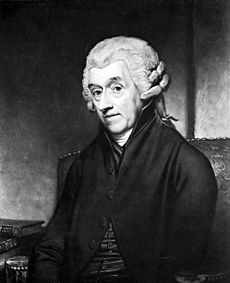William Heberden facts for kids
Quick facts for kids
William Heberden
|
|
|---|---|
 |
|
| Born | 13 August 1710 |
| Died | 17 May 1801 (aged 90) |
| Nationality | English |
| Alma mater | St John's College, Cambridge |
| Scientific career | |
| Fields | Medicine |
William Heberden (born August 13, 1710 – died May 17, 1801) was an important English physician. He is remembered for his careful observations of diseases. He helped doctors learn more about illnesses like chickenpox and angina pectoris.
Contents
Early Life and Education
William Heberden was born in London, England. He started his schooling at St Saviour's Grammar School. In 1724, he went to St John's College, Cambridge.
Becoming a Doctor
At Cambridge, he earned a special position called a fellowship around 1730. He became a Master of Arts in 1732. In 1739, he earned his degree as a doctor.
He stayed at Cambridge for about ten more years. During this time, he practiced medicine. He also taught classes every year about materia medica. This was the study of how medicines are made and used.
A Career in London
In 1746, William Heberden became a member of the Royal College of Physicians in London. Two years later, he moved to London permanently. He quickly became a very busy doctor.
In 1749, he was also chosen to be a member of the Royal Society. This is a famous group that promotes science. He worked as a doctor in London for over 30 years.
Later Years and Contributions
When he was 72 years old, Heberden started to work less. He spent his summers in Windsor. However, he still practiced medicine in London during the winter for several more years.
In 1778, he was made an honorary member of the Paris Royal Society of Medicine. This showed how respected he was internationally.
Heberden also suggested creating the Medical Transactions. This was a collection of medical observations from doctors. It helped share new information about diseases and their treatments.
Important Medical Discoveries
William Heberden was not only a doctor but also a good scholar. He wrote many papers for important scientific journals.
Understanding Diseases
He made important contributions to the Medical Transactions. He wrote about chickenpox in 1767. He also wrote about angina pectoris in 1768. Angina pectoris is a type of chest pain caused by heart problems.
His most famous work was Commentarii de morborum historia et curatione. This book was published after he died, in 1802. It was based on notes he took while treating patients. The book described many diseases and how to treat them.
Heberden's Nodes
You might hear about "Heberden's nodes" when people talk about osteoarthritis. These are bony bumps that can form on the finger joints. They are named after William Heberden. He wrote about them in his book on diseases.
Family Life
William Heberden was married twice. His first wife was Elizabeth Martin. They married in 1752 and had one son, Thomas. Sadly, Elizabeth died in 1754.
He then married Mary Wollaston. They had eight children together. Only two of their children lived longer than their father. One was William Heberden the Younger (1767–1845). He followed in his father's footsteps and became a doctor too. He even cared for King George III when the king was ill. His other surviving child was Mary (1763–1832).

